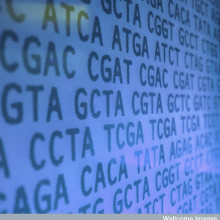We’re off to a festival - but before you worry about where your tent and wellies are, it’s the Festival of Genomics, held at a clean and dry conference centre in London rather than a muddy field full of rock bands and dodgy burgers. Plus, what does the public really think of genetic technology? And a fiery gene of the month. This is the Naked Genetics podcast for March 2018...
In this episode

01:06 - 100K on the way
100K on the way
with Mike Hubank, Royal Marsden Hospital
At the end of January Kat Arney headed down to the ExCeL conference centre in London’s Docklands to attend the Festival of Genomics - two days of talks, panels and other activities organised by Frontline Genomics, bringing together doctors, researchers, companies and the public to explore the latest in the UK’s fast-growing genetic technology sector. It was just like Glastonbury, but without the mud, cows, or Radiohead...
First up on the main stage was a panel discussion asking whether we will fully integrate genomics into the NHS within five years. One of the key parts of this challenge is the UK’s 100,000 Genomes project, run by Genomics England, which was launched by the Department of Health five years ago with the aim of doing what it says on the tin - sequencing 100,000 genomes from 70,000 people with cancer and rare diseases.
So far they’re halfway there, with 50,000 whole genome sequences in the bag. But what are they looking for, and what are doing with the information? Kat chased down one of the panellists, Mike Hubank, who runs the clinical genomics lab at the Royal Marsden Hospital in London, to find out. And, just like Glastonbury, as this and all the other interviews were recorded live at the festival, there’s a bit of background noise to contend with.

06:59 - Can we afford genomics?
Can we afford genomics?
with Gurdeep Sagoo, University of Leeds
Genomic technology is promising to revolutionise healthcare, and projects like 100,000 Genomes are sending us on the way. As the cost of sequencing falls, the excitement rises - so surely it’s getting cheaper all the time?
Alas, it’s not quite that simple, according to Gurdeep Sagoo, a lecturer in health economics at the University of Leeds who spoke at the Festival of Genomics as part of a fascinating panel discussion asking whether clinical genomics is financially sustainable. We can’t forget that the price tag needs to cover more than just the DNA sequencing itself, as he told Kat Arney.

15:34 - Public views on gene tech
Public views on gene tech
with Robin Lovell-Badge, Francis Crick Institute
This month the Royal Society released the results of a study uncovering public opinions about technologies such as genomics and DNA sequencing, gene editing and gene therapy. A survey of more than 2,000 people and detailed workshops showed cautious optimism for tools to improve human health, tackle the impacts of climate change and reduce inequality.
But other uses of genetic technology were less popular - such as attempts to manipulate eye colour or intelligence. So - what’s hot and what’s not in the public’s view of genetics? Kat Arney went to the Francis Crick Institute in London to meet Professor Robin Lovell-Badge, chair of the Royal Society’s genetic technologies programme, to find out why the Society commissioned the report, and what they learned from it.

20:48 - Democratising DNA
Democratising DNA
with David Smith, Mayo Clinic, Rochester
It’s all very well to talk excitedly of genome sequencing and targeted therapies, but who gets access to this technology, particularly if it comes with a high price tag? One of the speakers at the Festival of Genomics, Professor David Smith from the Mayo Clinic in Rochester, Minnesota, raised the issue of democratising genomics - making sure that everyone gets fair access to this potentially life-changing new area of medicine. So, asks Kat Arney, what does this look like, and are we there yet?

28:44 - A blockchain for genes
A blockchain for genes
with David Koepsell, Encrypgen
If you’ve been paying any attention to technology news lately, you’ve probably heard of something called a Blockchain - a giant spreadsheet that’s distributed in many places in the Cloud and remembers every edit you ever make. Eager companies are proposing blockchains as the solution to all kinds of problems, from banking and legal transactions to shopping and food safety.
So it was only a matter of time before someone came up with the idea of applying blockchain technology to genomic data, as Kat Arney found out when she spoke to David Koepsell, CEO of the company Encrypgen at the Festival of Genomics. According to David, this could provide a solution to some of the privacy and access issues that concern people when it comes to maintaining control over our own genetic data.

Gene of the Month - Smaug
Named after the fearsome dragon in JRR Tolkien’s fantasy novel The Hobbit, Smaug is the fiery foe that drives out the dwarves of Erebor from their caves under the Lonely Mountain. And then he sits there, on a massive pile of gold, until Bilbo Baggins and a bunch of dwarves turn up and kill him.
Just as Smaug the dragon inhibits the activities of the dwarves of Erebor, the fruit fly gene Smaug encodes a protein that inhibits the activity of another gene called Nanos, which is the Greek word for dwarf. It does this by binding to the message made when the Nanos gene is read - known as messenger RNA - and stopping it from being translated into a protein, but only when the Nanos RNA is in the wrong place in a fruit fly embryo. If this interaction doesn’t happen, then Nanos is made where it’s not needed, leading to stubby little maggots growing instead of elegant long ones.
Smaug is also found in mammals, and is often found located in small granules at the junctions, or synapses, between nerve cells, where it also stops messenger RNA being translated into proteins. It’s not entirely clear what its role is, but Smaug and other proteins that control message translation are thought to be involved in memory formation. So maybe my Smaug proteins are helping me to remember the plot of The Hobbit.
Related Content
- Previous Are other animals conscious?
- Next How does my computer work?










Comments
Add a comment